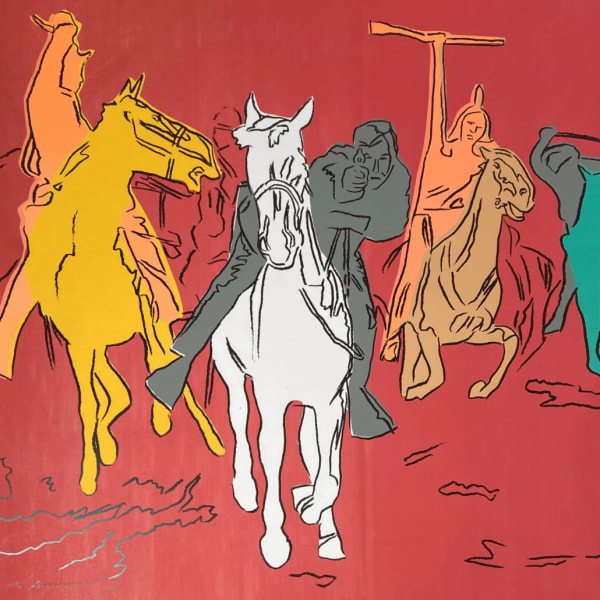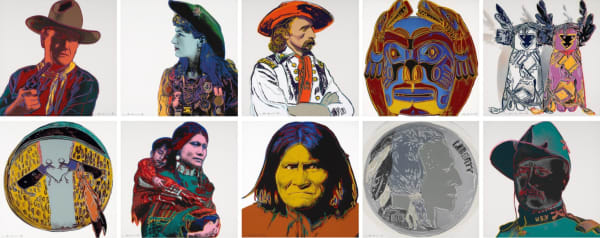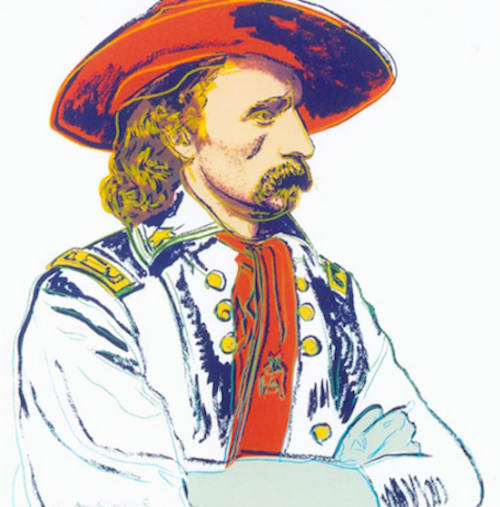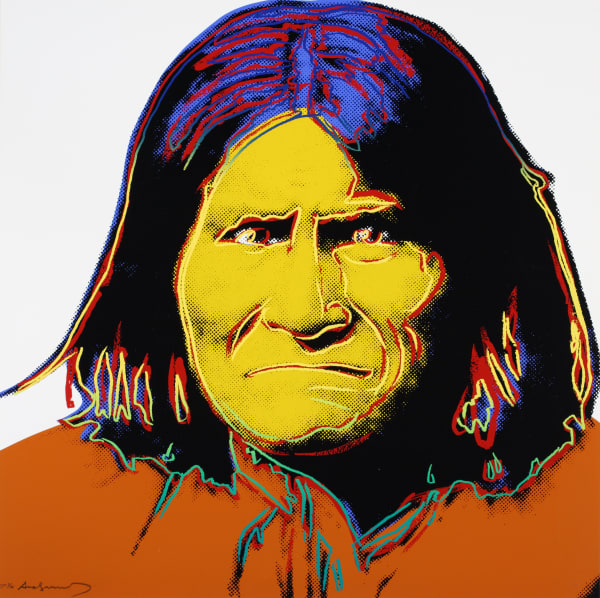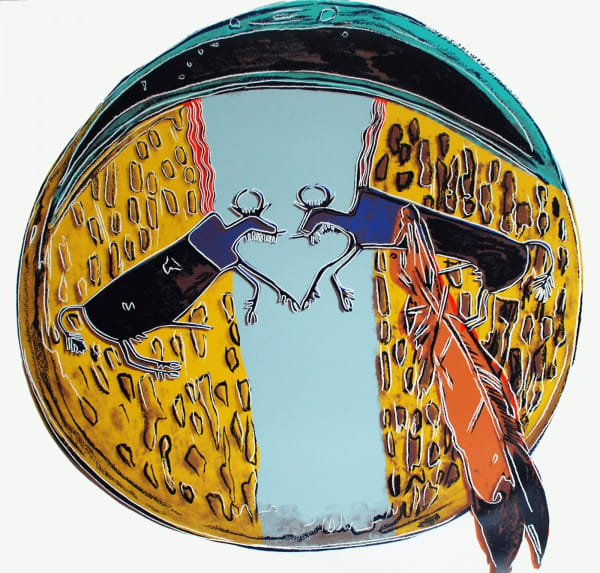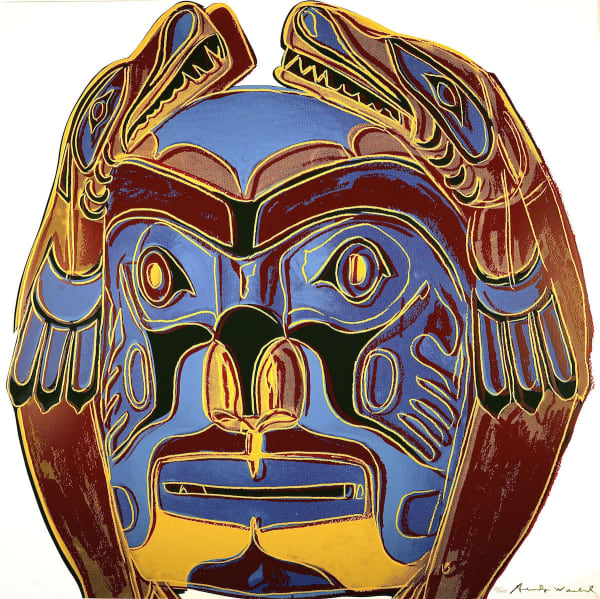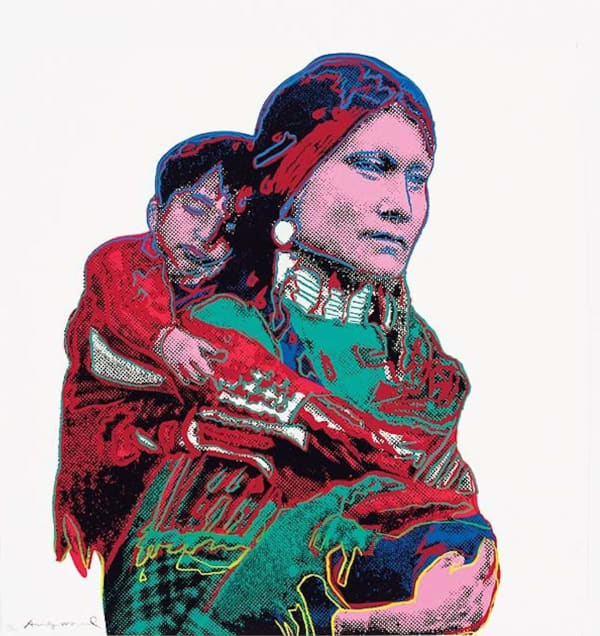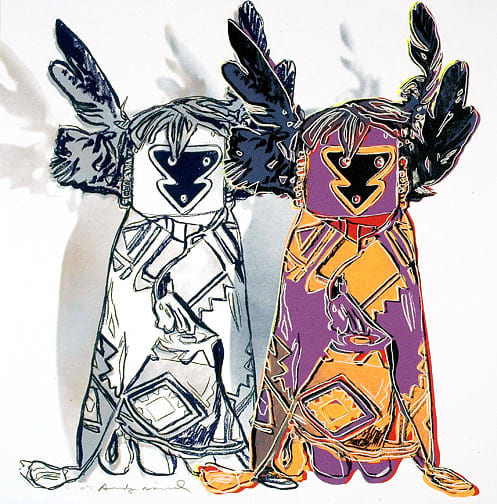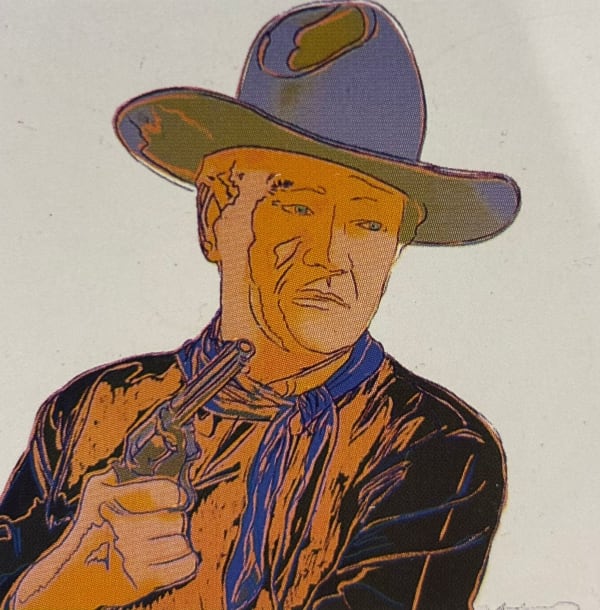
Andy Warhol
91.4 x 91.4 cm
Andy Warhol's fascination with American culture, iconography, and the intersection of art and commerce was exemplified in his series Cowboys and Indians, produced in the 1980s. One of the standout pieces from this series is Warhol's interpretation of the Indian Head Nickel (F & S. II 385).
Warhol's Indian Head Nickel print captures the essence of American imagery and mythology, reimagined through his unique lens. The Indian Head Nickel (F & S. II 385) itself is a potent symbol of the American West, evoking images of cowboys, Native Americans, and the frontier spirit. Originally designed by James Earle Fraser and minted from 1913 to 1938, the coin featured a profile of a Native American chief on one side and a buffalo on the reverse, making it an emblem of American identity.
In his rendition, Warhol amplifies the iconic status of the Indian Head Nickel by enlarging and isolating the image of the chief, removing it from its original context and placing it front and center. By isolating and enlarging the image, Warhol encourages viewers to scrutinize and reconsider the significance of this familiar symbol.
Warhol's use of vibrant colors and repetition in his prints is evident in the Indian Head Nickel piece. The bold, saturated hues he employs infuse the image with a sense of dynamism and contemporary flair, transforming a traditional image into a modern work of art. Additionally, the repetition of the image across the print creates a rhythmic pattern that draws the viewer's eye and adds layers of meaning to the piece.
Through his Indian Head Nickel (F & S. II 385) print, Warhol invites viewers to contemplate the complexities of American identity, history, and mythology. By recontextualizing this familiar symbol within the realm of contemporary art, Warhol prompts us to reassess our understanding of cultural icons and their significance in shaping national identity.
Overall, Warhol's Indian Head Nickel (F & S. II 385) print from the Cowboys and Indians series encapsulates his ability to transform everyday imagery into thought-provoking works of art. By blending elements of pop culture, history, and commerce, Warhol challenges viewers to reconsider the symbols and narratives that define American culture.
For more information on Andy Warhol’s Indian Head Nickel (F & S. II 385) or to buy Andy Warhol’s Indian Head Nickel (F & S. II 385), contact our galleries using the form below.
-
 Andy WarholAction Picture F.S. II 375, from Cowboys and Indians, 1986
Andy WarholAction Picture F.S. II 375, from Cowboys and Indians, 1986 -
 Andy WarholAnnie Oakley F.S. II 378, from Cowboys and Indians , 1986
Andy WarholAnnie Oakley F.S. II 378, from Cowboys and Indians , 1986 -
 Andy WarholBuffalo Nickel F.S. II 374, from Cowboys and Indians, 1986
Andy WarholBuffalo Nickel F.S. II 374, from Cowboys and Indians, 1986 -
 Andy WarholCowboys and Indians F.S. II 377-386 Cowboys and Indians, 1986
Andy WarholCowboys and Indians F.S. II 377-386 Cowboys and Indians, 1986 -
 Andy WarholGeneral Custer F.S. II 379, from Cowboys and Indians, 1986
Andy WarholGeneral Custer F.S. II 379, from Cowboys and Indians, 1986 -
 Andy WarholGeronimo F.S. II 384, from Cowboys and Indians, 1986
Andy WarholGeronimo F.S. II 384, from Cowboys and Indians, 1986 -
 Andy WarholPlains Indian Shield F.S. II 382, from Cowboys and Indians , 1986
Andy WarholPlains Indian Shield F.S. II 382, from Cowboys and Indians , 1986 -
 Andy WarholNorthwest Coast Mask F.S. II 380, from Cowboys and Indians , 1986
Andy WarholNorthwest Coast Mask F.S. II 380, from Cowboys and Indians , 1986 -
 Andy WarholTeddy Roosevelt F.S. II 386, from Cowboys and Indians , 1986
Andy WarholTeddy Roosevelt F.S. II 386, from Cowboys and Indians , 1986 -
 Andy WarholMother and Child F.S. II 383, from Cowboys and Indians , 1986
Andy WarholMother and Child F.S. II 383, from Cowboys and Indians , 1986 -
 Andy WarholKachina Dolls F.S. II 381, from Cowboys and Indians , 1986
Andy WarholKachina Dolls F.S. II 381, from Cowboys and Indians , 1986 -
 Andy WarholWar Bonnet Indian F.S. II 373, from Cowboys and Indians, 1986
Andy WarholWar Bonnet Indian F.S. II 373, from Cowboys and Indians, 1986 -
 Andy WarholJohn Wayne F.S. II 377, from Cowboys and Indians, 1986
Andy WarholJohn Wayne F.S. II 377, from Cowboys and Indians, 1986 -
 Andy WarholPlains Indian Shield F.S. II 382, from Cowboys and Indians , 1986
Andy WarholPlains Indian Shield F.S. II 382, from Cowboys and Indians , 1986 -
 Andy WarholNorthwest Coast Mask F.S. II 380, from Cowboys and Indians , 1986
Andy WarholNorthwest Coast Mask F.S. II 380, from Cowboys and Indians , 1986 -
 Andy WarholKachina Dolls F.S. II 381, from Cowboys and Indians , 1986
Andy WarholKachina Dolls F.S. II 381, from Cowboys and Indians , 1986 -
 Andy WarholAnnie Oakley F.S. II 378, from Cowboys and Indians , 1986
Andy WarholAnnie Oakley F.S. II 378, from Cowboys and Indians , 1986 -
 Andy WarholJohn Wayne F.S. II 377, 1986
Andy WarholJohn Wayne F.S. II 377, 1986
Join our mailing list
* denotes required fields
We will process the personal data you have supplied in accordance with our privacy policy (available on request). You can unsubscribe or change your preferences at any time by clicking the link in our emails.
This website uses cookies
This site uses cookies to help make it more useful to you. Find out more about cookies.
